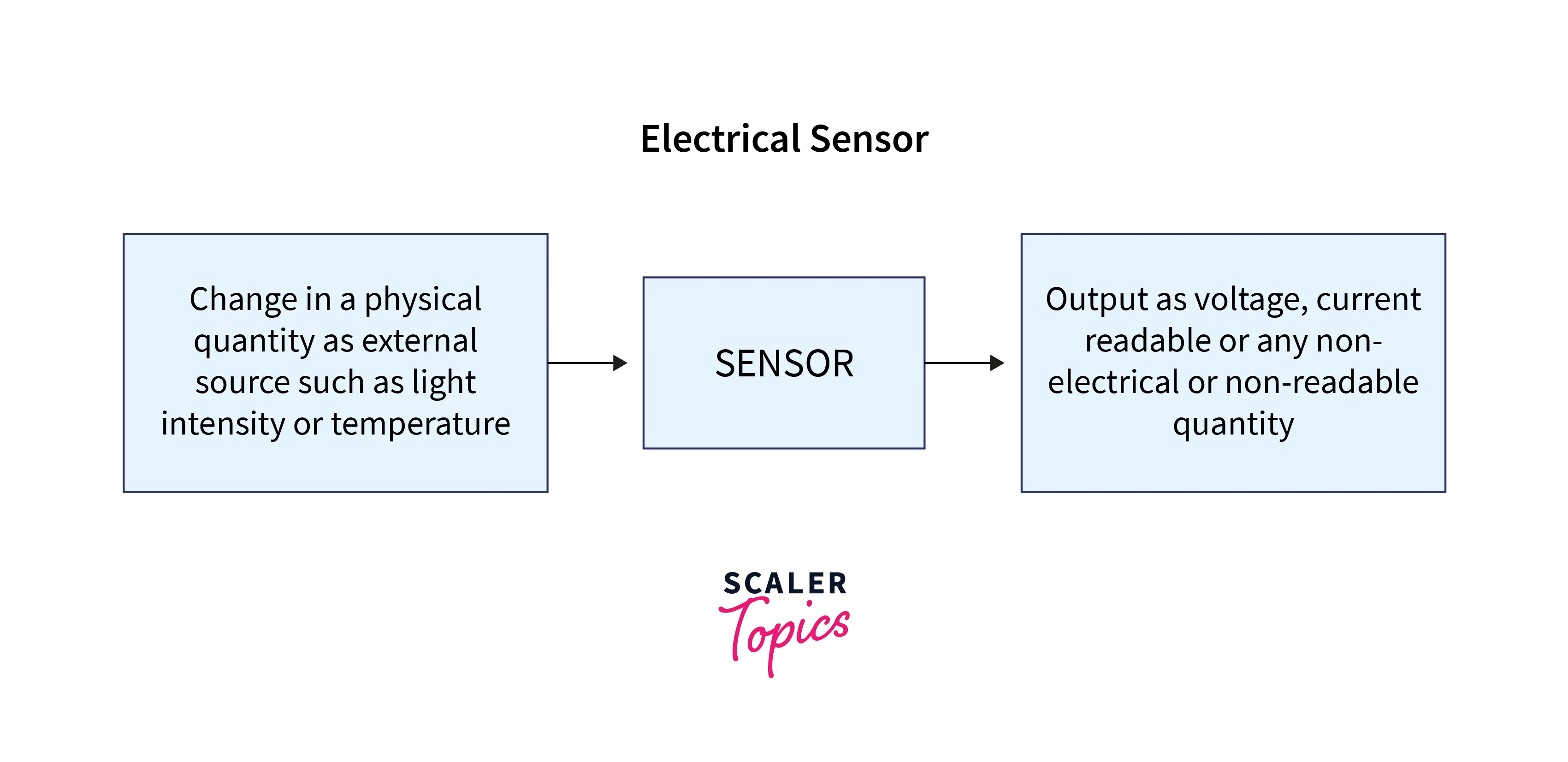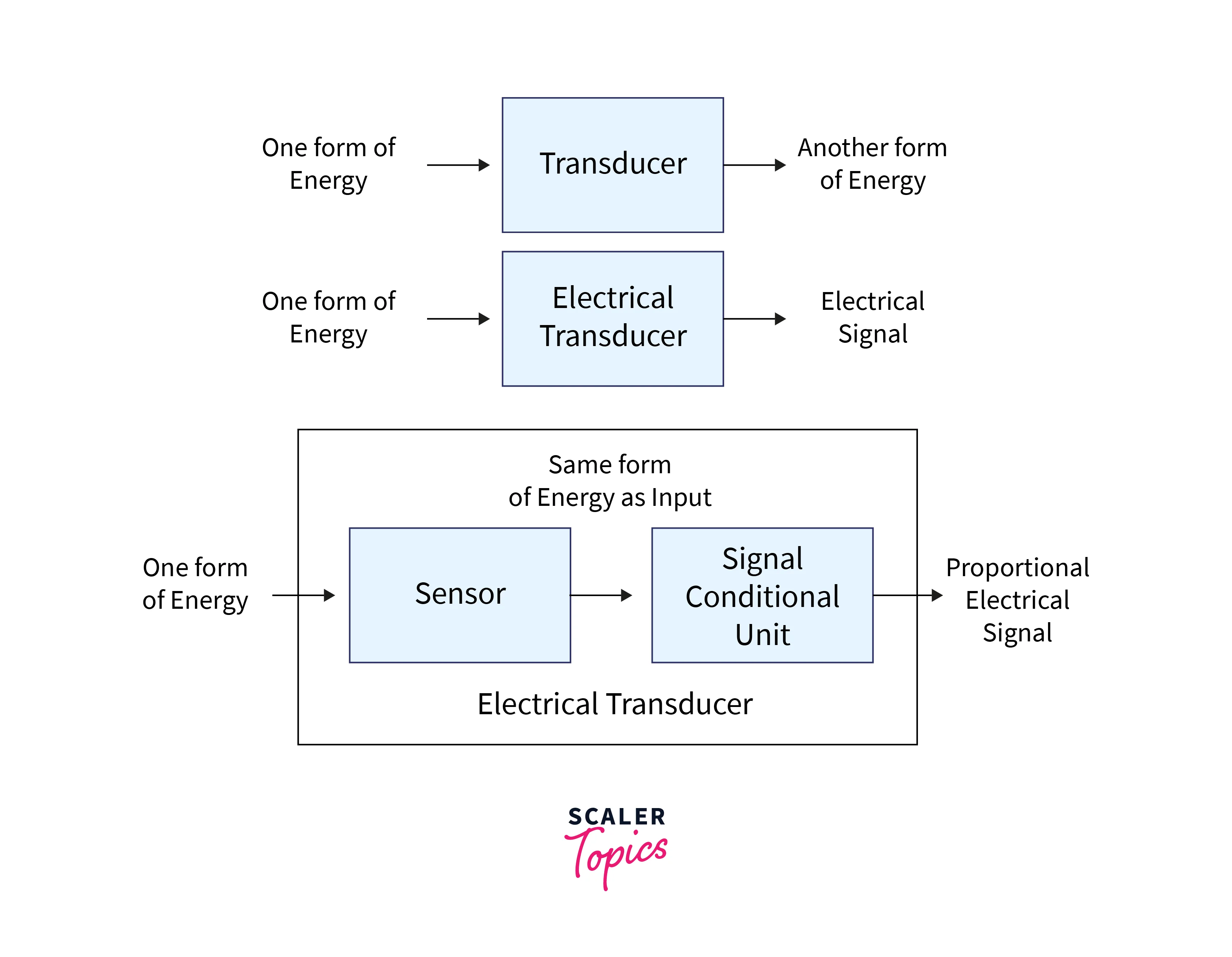Difference between Sensor and Transducer
Overview
Sensors primarily focus on detecting and measuring physical properties and converting them into electrical signals, while transducers encompass a wider range of devices that can convert various forms of energy, including both sensing and actuation functions. Sensors are a subset of transducers, and their primary function is to sense physical quantities and provide corresponding electrical output.
What is a Sensor?
A sensor is a device that quantitatively detects and measures specific physical properties or changes in the environment and converts this information into an electrical signal or readable output.

Characteristics of Sensors
-
Detection:
Sensors are designed to identify and recognize particular physical phenomena or conditions, such as temperature, light levels, pressure, motion, humidity, or other measurable attributes.
-
Measurement:
Once a sensor detects the targeted property, it quantifies it by providing a numeric value or signal that represents the property's magnitude. This measurement reflects the intensity or level of the detected phenomenon.
-
Conversion:
Sensors typically transform the measured data into an electrical signal. In some cases, this signal may also be in digital form, depending on the sensor's type and application. The conversion is primarily intended for further processing or analysis.
-
Output:
The resulting electrical signal or data can be used for various purposes, such as displaying the information on a screen, storing it for analysis, or controlling other devices or systems based on the measured data. Sensors provide data for monitoring and decision-making.
Sensors in IoT
-
Data Collection:
Sensors are vital for collecting real-world data in IoT devices. For example, in a smart thermostat, temperature sensors detect the ambient temperature, and environmental sensors may monitor humidity levels. In an industrial IoT setting, sensors can measure factors like pressure, flow rates, or vibration.
-
Data Transmission:
Once sensors gather data, they transmit this information to IoT platforms or cloud services. This data transmission can occur wirelessly (e.g., through Wi-Fi, Bluetooth, Zigbee) or via wired connections (e.g., Ethernet).
-
Analysis:
IoT platforms process and analyze the data received from sensors. Algorithms and machine learning models can identify patterns, anomalies, or trends in the data, providing valuable insights into the environment or system being monitored.
-
Decision-Making:
Based on the analysis results, IoT systems can make informed decisions. For instance, a smart home IoT system might use temperature and occupancy data from sensors to decide when to adjust the thermostat for energy efficiency or comfort.
-
Remote Control:
IoT devices often allow remote control or management through mobile apps or web interfaces. Users can remotely adjust settings or receive alerts based on the sensor data. For instance, a homeowner can change the thermostat's temperature setting using a smartphone app.
What is a Transducer?
Transducers convert one form of energy into another, including both sensing (detecting physical data) and actuation (performing physical actions). They enable bidirectional communication between devices and the physical world, encompassing sensors and actuators.

Characteristics of Transducers
-
Energy Conversion:
Transducers encompass the broader concept of converting energy from one form to another. This can include converting physical properties into electrical signals, mechanical movements, acoustic waves, optical signals, or thermal energy.
-
Sensing and Actuation:
Transducers can include both sensing and actuation functions. While some transducers are designed to sense physical phenomena and convert them into electrical or other forms of output, others are equipped to actuate or produce physical effects based on electrical input.
-
Versatility:
Transducers have a wide range of applications beyond sensing. They are used in scenarios where the conversion of energy between different forms is necessary. For example, they can actuate devices like motors, speakers, or relays, in addition to sensing applications.
-
Interaction with the Physical World:
Transducers enable devices to interact with the physical world by converting signals or data into actions. For example, a transducer with actuation capabilities can adjust the temperature in a smart thermostat or control the movement of a robotic arm based on input data.
Transducers in IoT
-
Actuation Capabilities:
Transducers, especially those equipped with actuation capabilities, enable IoT devices to interact with the physical world. These actuation components can include motors, solenoids, relays, or any device that can perform a physical action.
-
Examples of Actuation:
In the context of IoT, transducers may be used as actuators in various ways. For instance:
In a smart thermostat, a transducer (actuator) could be a motor that adjusts the temperature control knob based on input from temperature sensors.
In a home automation system, transducers may control lights, blinds, or door locks based on user commands received from IoT platforms.
-
Enhanced Control:
Transducers add an element of control to IoT systems. They can respond to commands, allowing IoT devices to influence the physical environment. This is particularly valuable in scenarios where real-world actions need to be triggered based on sensor data.
-
Integration:
IoT systems often integrate sensors and transducers to create closed-loop control systems. For example, sensors might detect that a room is too dark, and actuators (like smart light bulbs) can be triggered to adjust the lighting accordingly.
Difference between Sensor and Transducer
| Characteristic | Sensor | Transducer |
|---|---|---|
| Detection | Identifies specific physical properties or conditions (e.g., temperature, light, pressure). | Can also detect physical properties but can encompass a broader range of functions. |
| Measurement | Quantifies the detected property, providing a numeric or signal value representing its magnitude. | May measure physical properties but can also perform actuation or energy conversion. |
| Conversion | Transforms measured data into electrical signals or digital output for further processing. | Converts energy between various forms, including electrical, mechanical, acoustic, optical, or thermal. |
| Output Type | Typically provides electrical signals or digital data as output. | Can have various types of outputs, including electrical, mechanical, acoustic, optical, or thermal energy. |
| Primary Focus | Focused on sensing and data collection, providing input for monitoring and analysis. | Encompasses both sensing and actuation functions, enabling interaction with the physical world. |
| Examples | Temperature sensor, pressure sensor, motion detector. | Microphone, loudspeaker, piezoelectric sensor. |
| Applications | Widely used for environmental monitoring, industrial automation, consumer electronics, and more. | Utilized in sensors but also actuators, making them versatile in applications like robotics, audio systems, and control systems. |
Conclusion
- A sensor is a device that detects and measures physical or environmental conditions and converts them into electrical or digital signals for monitoring or control purposes.
- A transducer is a device that converts one form of energy or physical quantity (e.g., pressure, temperature, light) into another, typically electrical signals, for various measurement or control applications.
- A sensor is a component itself while a transducer contains a sensor as a component in addition to the signal conditioning unit.
- A sensor is not necessarily a transducer while a transducer must include a sensor.
